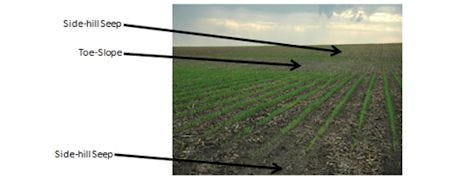June 27, 2013

Iowa's wet spring and cool temperatures not only slowed planting progress but also slowed Growing Degree Day accumulations. These factors contributed to yellow corn plants across the state as well as within-row variability in plant-to-plant growth and development. Seedling diseases reduced corn stands.

WHAT YOU CAN DO ABOUT SEEPS: Iowa mudded through its wettest spring on record this year. Among the many challenges, the extensive spring precipitation fostered ideal conditions for sidehill seeps. ISU Extension soil management specialist Mahdi Al-Kaisi says this is a good year to evaluate your field conditions and develop a management plan to alleviate sidehill seep problems.
"We might expect all of those problems to surface in a spring like this, considering the conditions the crop has experienced," says Roger Elmore, Iowa State University Extension corn agronomist. "We expect stand losses in low areas of fields in wet years due to prolonged standing water on planted or emerged corn. However, one rarely seen problem has developed this year -- corn stand losses on sidehills." Elmore, along with a colleague, ISU Extension soil management specialist Mahidi Al-Kaisi, offer the following information and management recommendations regarding sidehill seeps.
Saturated soils result in reduced corn stands in Iowa this spring
Saturated soils on sloped areas (Figures 1 and 2) with corn planted in the second or third week in May resulted in poor germination and damping off and, in some cases, dramatically reduced stands. Soil temperatures at and soon after planting were conducive for rapid germination and emergence. "So, we can rule out temperature as a causal agent," says Elmore. In some cases, the seed swelled (imbibed water) but neither the radical nor mesocotyl emerged. In cases where the radical and/or mesocotyl did emerge, they died before much growth occurred (Figure 3). ISU colleagues at the Plant and Insect Diagnostic Clinic are examining seedlings for pathogens this year.~~~PAGE_BREAK_HERE~~~
One of the possible reasons for stand losses on sidehill slopes, also known as the mid-slope (Figure 2), is water seepage leading to continuously saturated conditions and thus a lack of oxygen supply for seedlings to develop. Areas with water seepage like this are called 'sidehill seeps.'
Sidehill seeps -- what causes them? Is there a practical way to avoid this problem?
One of the main reasons for sidehill seepage is existence of an impermeable layer or pan layer of soil that restricts vertical water movement into the soil profile (Fig. 2), note the two ISU Extension agronomists. Also, in some cases it can be related to lateral flow where a layer of sand and gravel sandwiched between glacial debris channels water to the side- or mid-slope. "This impermeable layer probably lies just below the area where the emergence failure occurred," says Al-Kaisi.
One of the practices to alleviate problems in areas with sidehill seepage is planting deep-rooted perennials. Either alfalfa or perennial grasses will reduce soil moisture and prevent potential saturated conditions in seep areas. Reduced or no-till alleviates the problem as well, say the ISU agronomists.
Do higher pH soils tend to be found in saturated areas of fields?
The potential for higher pH soils in saturated areas exists in addition to issues with stand establishment, notes Al-Kaisi. Generally, water associated with sidehill seeps is high in dissolved minerals such as calcium and may create an alkali condition. If highly dissolved salts exist, salinity may result in crop failure in these seep areas. Continuous row cropping in these areas may reduce soil quality and increase soil erosion and water ponding conditions at the lower portion of the slope length -- the toe-slope (Figure 2).
SUMMING UP: Extensive spring 2013 precipitation fostered ideal conditions for sidehill seeps. Soil profiles were saturated and excess water moved laterally due to downward vertical flow restrictions. This soil saturation occurred during critical stages of germination and early stages of growth. These conditions deprived seedlings of oxygen necessary for growth and/or slowed growth to the point where pathogens were able to overcome the struggling seedlings. Corn stands were compromised.
"Evaluate field conditions during wet conditions and document areas with sidehill seepage," says Al-Kaisi. "Develop a management plan that may include conservation tillage, use of no-till, tiling, and/or planting perennials with deep roots to utilize excess moisture. These practices will help alleviate sidehill seep problems in the future."
You May Also Like




